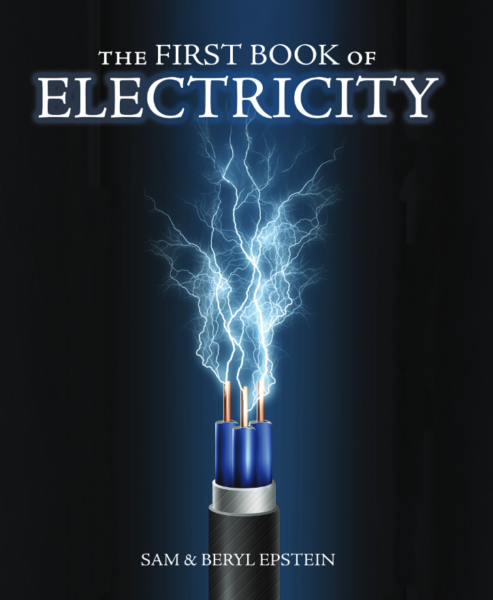In this Form 2 (grade 4-6) study guide, students will be introduced to what electricity is, how it is generated, how it flows through wires, and how it is harnessed in our homes and engines.
The study guide includes reading assignments from the spine text, narration prompts, and open discussion questions. Experiments related to the reading are also included. Optional supplemental activities, such as current events, videos, and article suggestions when there is time, are also included. Finally, you will find a link to an exam for each course in the introductory material.
- Pages: 73
- Prerequisites: none
Spine Text

This study guide accompanies the living book The First Book of Electricity by Sam and Beryl Epstein (Living Book Press, 2025, ISBN: 9781761534256; or Living Library Press, 2019, ISBN: 0578582392), which must be purchased separately.
- 74 pages
- Reading Level: 4-6 grade
- Prerequisites: none
- Reading assignment include page numbers for Living Book Press (LBL) and Living Library Press (LLP).
Sam and Beryl Epstein were wed in 1938 and spent their whole married life writing together. They both brought many things to their partnership which helped them to make a great team. Beryl had been a journalist and an editor and Sam was formerly a science editor and editorial consultant in the department of microbiology at Rutgers University. They were both passionate researchers with a great deal of curiosity and loved to write about scientists, explorers, and other pioneers and show how scientific discoveries affected historical events.
They were well suited for writing books for “The First Book of…” series, known for helping younger readers in developing a scientific outlook toward their world. Altogether the duo wrote more than 150 books. —Michele Jahncke (source)
Other Necessary Items to Complement This Course
- Review the Supply List for this course.
- Handbook of Nature Study by Anna Botsford Comstock
Schedule:
This study guide includes 33 morning lessons, three per week, each requiring approximately 20-30 minutes. Each week will include the following science lessons:
- Weekly Lesson 1: Nature Lore
- Weekly Lesson 2: Natural History Science Reading and sometimes an activity
- Weekly Lesson 3: Special Studies Reading or Natural History Activity
Other necessary science and nature study should be done during afternoons or evenings, and may include the following:
- Daily work outside exploring and investigating, making notes or drawings of their observations. Due to the subject matter of this study guide, some of this daily work will need to be done after sunset.
- Additional reading on this science topic and nature topics according to individual desire and interest.
I feel that my entire foundational understanding of living science – what it means and how to capture it within my home – was developed through following Nicole and her work with Sabbath Mood Homeschool. Reading her recommendations, listening to her explanations, and using her materials has given me the confidence I needed to guide my children effectively and with a smile.
—Amber Johnston, Atlanta, GA
Sample Lessons:
A digital version can be purchased below, but the paperback copies of this study guide must be purchased on Amazon.
Neither the study guide nor the accompanying spine text includes religious content. Therefore, a separate secular version is not available.
SMH offers discounted prices for Co-Op and Schools. If you are purchasing for Co-Ops, please refer to this page. For School License, please refer to this page.
Reviews
We are just about to dive into this study and I am impressed with the book and the guide that accompanies it. I think that Nicole’s instructions in the guide are clearer than those in the book, and the extra activities that she lays out are valuable additions. My fifth grader is excited to explore electricity this coming term.
We loved learning about electricity with this study. My kids still talk about electrons moving in a current and point out transformers that we encounter in real life. Thank you for a great product!
The book by Sam and Beryl Epstein was clear and easy to read and Nicole’s guide helped me and my Form 2 students engage with the concepts behind electricity. I was glad that I could borrow the living book via the Internet Archive even though I hadn’t been able to buy a copy.
The projects in this course have created a lot of excitement for my students. As a mom and teacher I appreciate the easy to follow shopping lists which makes science so easy to do at home.
We loved our study of energy last year. The First Book of Electricity was dated, but fantastic, and easy to give updated explanations to my kids (mostly about a circuit breaker replacing a fuse box). My oldest in particular loved the experiments and it’s the most excited I’ve seen her about science.
Almost all of the experiments from the SMH guide were in the book, so the guide felt a bit redundant, especially as instructions for the experiments weren’t always clearer. Some of the experiments weren’t well explained and so it could be tricky to get them to work.
However, I appreciated the supply list and that the book was already broken down into appropriate lesson lengths.
You must log in to submit a review.








